
Basketball Coaching DVD's at Championship Productions
ZIPPER OFFENSE
During the 1960's, the Boston Celtics were successful in winning a longer string
of consecutive championships than any team in the history of professional sports
running the zipper offense. This offense has been used for a variety of
reasons to either enter into an offense or to run it as an offense all to its
own. This article will discuss the advantages and disadvantages of the
zipper offense as well as ways to run it, some plays that go along with it, and
ways to teach this outstanding offense to your players.
Advantages of the Zipper Offense
There are a number of reasons as to why a coach would want to run the zipper
offense. They include:
-
Versatility. The zipper offense can be run
from a number of different sets. Anything from a 2-1-2 set to
a 1-2-2 box to a 1-4 high set can be used to get into the offense.
This allows the coach to use different formations to run the same
basic plays.
-
The ability to run multiple plays. Because
there are several plays that can be run using the zipper set, you
can adjust the offense to your personnel. I will show a myriad
of plays that will provide some ideas as to how you can run the
offense to best fit what your players can do well.
-
The ability to enter into another offense. The
zipper preset can be used to get into motion offense, flex offense,
shuffle offense, or a pick-and-roll offense easily. By running
the basic preset, the zipper offense can be used as a quick hitter
to score right away or to get into the offense if the quick hitter
doesn't score right away.
Disadvantages of the Zipper Offense
However, like most set offenses, the zipper offense does have its disadvantages
which include the following:
-
Like most set offenses, the zipper offense can be
easily scouted. Because the offense relies on specific calls
to run specific plays, the offense is tipped off to the people in
the stands, including opposing coaches watching the game. The
only way to counteract coaches from picking up on your calls and
tendencies is to have a high volume of offensive plays from the set.
-
The zipper offense also requires that you need to
have certain elements of offense that your defense sees on a regular
basis. This requires that your team spend separate practice
time working on other offensive concepts that are not incorporated
in your set offense.
-
Putting in the zipper offense also means that you
will need to have another offense that you can enter into once you
have run the quick hitting play without attempting a shot. If
you choose not to have an offense that your team can easily flow
into, your team will require quick shots out of the zipper offense.
Those quick shots could ultimately mean the difference between
winning and losing games.
Basic Zipper Plays
When entering the zipper offense, we have four basic reads for our point guard
when entering into the offense. The first read is the back cut by the
wing. If we are playing a pressure defense, we can look to get this entry
by having the wing fake high then cut back door (Diagram 1). A defender
actively denying the wing will be brought out away from the basket creating a
moment of separation where our point guard can enter the ball to the cutter for
a lay-up.
The second option for the point guard is to turn the corner if his defender is
guarding him too high. In Diagram 2, the defender is shown as being too
high and too far behind the dribbler. We give the point guard some
latitude to attack the rim if this develops; however, we will hold the point
guard accountable.
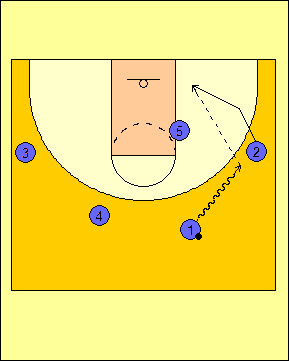
Diagram 1 |
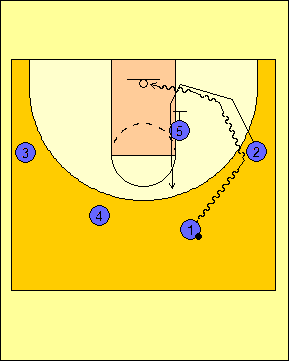
Diagram 2 |
The third option is how we read the down screen. This works two ways:
The first is that the cutter comes off of the down screen cleanly and the
defense doesn't switch the screen as shown in Diagram 3. We look for the
cutter first and will pass him the ball. If he gets the ball, we will run
the play. If he gets overplayed, we will dribble him out with a back cut
as shown in Diagram 4.
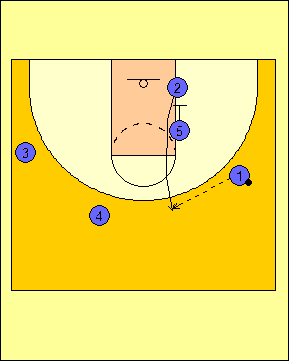
Diagram 3 |
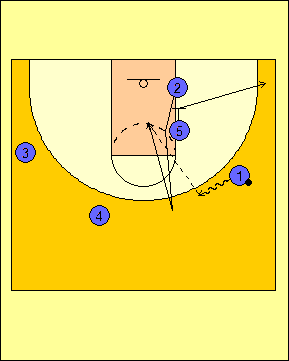
Diagram 4 |
The fourth option is the post up. This works one of two ways: The
first is that the post man comes open after setting the screen and the cutter
receives the pass. We only look for this post up if the screener does not
have to get involved in the play as a screener (Diagram 5).
The other is when the screen gets switched by the defense. Here, we want
to go right inside and exploit the switch to our advantage (Diagram 6).
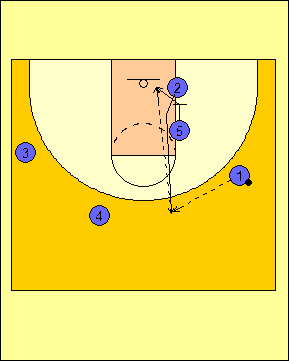
Diagram 5 |
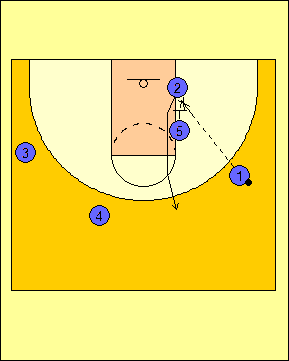
Diagram 6 |
Read the full article and many others by signing up for a Coach Peel
Basketball membership today.
Membership Subscription with Monthly Payments: $6.00 per
month
Membership Subscription with Quarterly Payments:
$15.00 per quarter (save over 16.6%)
Membership Subscription with Annual Payments: $50.00 per
year (save over 30.5% & get your first 30 days free!)

© 2010-2017 Alan Peel Enterprises